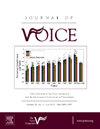Time-Synchronized MRI-Assessment of Respiratory Apparatus Subsystems—A Feasibility Study
IF 2.5
4区 医学
Q1 AUDIOLOGY & SPEECH-LANGUAGE PATHOLOGY
引用次数: 0
Abstract
The thorax (TH), the thoracic diaphragm (TD), and the abdominal wall (AW) are three sub-systems of the respiratory apparatus whose displacement motion has been well studied with the use of magnetic resonance imaging (MRI). Another sub-system, which has however received less research attention with respect to breathing, is the pelvic floor (PF). In particular, there is no study that has investigated the displacement of all four sub-systems simultaneously. Addressing this issue, it was the purpose of this feasibility study to establish a data acquisition paradigm for time-synchronous quantitative analysis of dynamic MRI data from these four major contributors to respiration and phonation (TH, TD, AW, and PF). Three healthy females were asked to breathe in and out forcefully while being recorded in a 1.5-Tesla whole body MR-scanner. Spanning a sequence of 15.12 seconds, 40 MRI data frames were acquired. Each data frame contained two slices, simultaneously documenting the mid-sagittal (TH, TD, PF) and transversal (AW) planes. The displacement motion of the four anatomical structures of interest was documented using kymographic analysis, resulting in time-varying calibrated structure displacement data. After computing the fundamental frequency of the cyclical breathing motion, the phase offsets of the TH, PF, and AW with respect to the TD were computed. Data analysis revealed three fundamentally different displacement patterns. Total structure displacement was in the range of 0.94 cm (TH) to 4.27 cm (TD). Phase delays of up to 90 (i.e., a quarter of a breathing cycle) between different structures were found. Motion offsets in the range of -28.30 to 14.90 were computed for the PF with respect to the TD. The diversity of results in only three investigated participants suggests a variety of possible breathing strategies, warranting further research.
呼吸装置子系统的时间同步磁共振成像评估--一项可行性研究。
胸廓(TH)、胸膈肌(TD)和腹壁(AW)是呼吸器官的三个子系统,磁共振成像(MRI)对这三个子系统的位移运动进行了深入研究。然而,另一个与呼吸有关的子系统是骨盆底(PF),其研究关注度较低。特别是,目前还没有研究同时调查所有四个子系统的位移。针对这一问题,本可行性研究的目的是建立一种数据采集范式,用于对呼吸和发音的四个主要贡献者(TH、TD、AW 和 PF)的动态 MRI 数据进行时间同步定量分析。三名健康女性被要求在 1.5 特斯拉全身磁共振扫描仪中记录时用力吸气和呼气。在 15.12 秒的序列中,共采集了 40 个核磁共振成像数据帧。每个数据帧包含两个切片,同时记录中矢状面(TH、TD、PF)和横断面(AW)。使用肌动图分析法记录四个相关解剖结构的位移运动,从而得到随时间变化的校准结构位移数据。在计算周期性呼吸运动的基频后,计算出 TH、PF 和 AW 相对于 TD 的相位偏移。数据分析显示了三种基本不同的位移模式。结构总位移在 0.94 厘米(TH)到 4.27 厘米(TD)之间。不同结构之间的相位延迟高达 90∘(即四分之一个呼吸周期)。计算出 PF 相对于 TD 的运动偏移范围为 -28.30∘ 至 14.90∘。仅在三名受试者中得出的不同结果表明,可能存在多种呼吸策略,值得进一步研究。
本文章由计算机程序翻译,如有差异,请以英文原文为准。
求助全文
约1分钟内获得全文
求助全文
来源期刊

Journal of Voice
医学-耳鼻喉科学
CiteScore
4.00
自引率
13.60%
发文量
395
审稿时长
59 days
期刊介绍:
The Journal of Voice is widely regarded as the world''s premiere journal for voice medicine and research. This peer-reviewed publication is listed in Index Medicus and is indexed by the Institute for Scientific Information. The journal contains articles written by experts throughout the world on all topics in voice sciences, voice medicine and surgery, and speech-language pathologists'' management of voice-related problems. The journal includes clinical articles, clinical research, and laboratory research. Members of the Foundation receive the journal as a benefit of membership.
 求助内容:
求助内容: 应助结果提醒方式:
应助结果提醒方式:


